
| The
textual contents of this site remain © 2013 by Bob Staake.
The art is © 2013 by Karl and Elsie Hubenthal - All Rights
Reserved. No portion of this web site may be used without the
consent of the copyright owners. |
|
|
 
-
| A
Tribute to One of the All-Time Great Cartoonists and Illustrators |
-
-
-
-
-
-
| A prodigy of Karl's explains what Hubenthal
meant to him -- and offers some observations and insights into
his work. |
-
By Bob Staake
Copyright © 2013 by Bob Staake
All Rights Reserved |
|
He was the first cartoonist
I ever wrote to, the first to write me back, the first to invite
me to his studio, the first to give me an original drawing.
Karl Hubenthal was just that kind of guy.
Growing up in Los Angeles
in the 1960's, there were two types of people -- those who read
the Los Angeles
Times, and those
who read the Los
Angeles Herald-Examiner
-- and our family was of that latter persuasion -- Dad not knowing
that the "Herald" wasn't the best of papers, Mom not
really caring, and me delighted just to be able to see Hubenthal's
cartoons each day.
|
|
Hubenthal. I'd heard
it said as "hoo-ben-thal" once or twice, yet Dad had
always pronounced it (rightly) "hugh-ben-thal", and
while at the time I wasn't sure which was correct, one thing
was certain: this Hubenthal could draw.
His lush, intoxicating
sports cartoons were the first thing I recognized -- bold, high
contrast, wildly animated, brilliantly executed -- and reproduced
almost head to toe on the front page of the Herald's sports page.
Only later did I begin taking note of his political cartoons.
I studied them, I clipped them out, I taped them to my bedroom
walls. Most kids spent hours alone drooling over smuggled copies
of Playboy -- I ldrooled over Hubenthal
cartoons.
I last saw Karl in
April of 1998 at the National
Cartoonists Society Reuben Weekend in Los Angeles. He looked well. At that time
I was honored to receive the NCS Reuben Award for my Newspaper
Illustration work, and nothing delighted me more than winning
the award in the presence of Karl and Elsie. Afterwards, Karl
beamed and congratulated me, and I explained that had he not
encouraged me as a young teenager, I probably wouldn't have grown
up to become a professional cartoonist myself. Karl, of course,
in his typically humble manner, would hear nothing of it -- insisting
he only did for me what his mentor, Willard Mullin, did for him.
I had no idea that
would be the last time I would see Karl.
I thought about him
for months afterward. I looked through files of his old cartoons.
I reflected on my memories of him, and one thing was certain:
I wanted to "give something back to Karl". In January
of 1999, I called Elsie with my suggestion for a comprehesive
web site -- an authoritative internet home for Karl and his work.
She thought it was a splendid idea.
Please enjoy it .
All we can hope for
is that Karl finally has internet access!
Bob Staake
I was sixteen in 1974 when I
first met Hubenthal at his home studio, and when the tall, goateed
man greeted me at the door with a broad smile and that baritone
voice of his, it sounded eerily like the guy in The Grinch Who Stole Christmas TV special who sings the title
song. Booming, strong, lowwwwww.
He was gracious, and
he was kind -- clearly he remembered being young and in my position
-- perhaps when he first met George
Herriman -- and
so he insisted I call him "Hubie"and then proceeded
to put me at ease by showing me around his studio.
|

A Hubenthal
self-caricature
|
|
It
was just how I had imagined it would look. Original cartoon art
by the greats on his walls, neat rows of reference books, another
wall of awards and photos of him with Presidents, filing cabinets
filled neatly with reference, an easle with a painting in progress,
a long counter for spreading things out, and finally an angled,
kingly-looking drawing table. Beside the table was a "tabouret"
with pens, pencils, brushes, an ink well, bowl of fresh water,
and a old-fashioned headset connected to a rotary phone dialer
that I assumed allowed Hubenthal to work on a drawing with two
hands while he took important calls from some cigar-chomping,
gruff-voiced editor downtown at the Herald-Examiner city room. |
My eyes drifted all
over the room, he showing me this and that, but for some reason
I was most interested in his filing cabinets. "That's where
I keep my scrap", said Hubenthal. I played along, I'm sure,
doing my best to convince him I knew what "scrap" was.
He pulled out the top drawer revealing a conga line of manila
dividers and folders, each tab with various words written in
that beautiful Hubenthal hand-lettering of his: Egypt, Aircraft Carriers, Soviet
Party Leaders, Bears --
you name it. He tugged out a folder titled Ocean Liners and
opened it to show me a dozen or so perfectly clipped magazine
photos of huge boats taken from every conceivable angle. He explained
that most cartoonists had these filing cabinets loaded with photos,
which they called their "morgues". Two new words that
day -- "scrap" and "morgue". Hubie put the
photos back in the folder, but instead of just tossing it on-top
of the filing cabinet, he put it back where he found it -- somewhere
between New York
City and Owls. The message wasn't lost on me: "Be organized".
We sat down and talked
cartooning all that morning. Hubie praised the cartoons I brought
along, he told me to go to college, he explained how a little
talent and a lot of hard work makes for good cartoonists and
how editorial cartoons were about ideas through art, not the
other way around. He inspired me.
We became friends that
day, later colleagues. Indeed on that morning in 1974, Karl Hubenthal
firmly convinced me that I would in fact become a professional
cartoonist, and for his encouragement, creative generosity and
friendship, I shall always be grateful.
|
-
-
 |
|
Biographical and clinical information
about Karl Hubenthal abounds on this web site. However, I think
it is important for me to provide here an observational analysis
on a few issues that I hope will set the record straight and
put Karl Hubenthal, and his work, in the proper historical context.
Bob Staake
|
-
|
When it comes to creating art
for reproduction, any cartoonist or illustrator is saddled not
only with the need to create a piece of artwork that indeed "works"
on both conceptual and aesthetic levels, but also prints cleanly,
and readably, on cheap newsprint for millions of eyes to see.
Indeed, the mass-communicative arts are not ideally suited for
wispy, aesthically tenuous, or even hyper-detailed artwork that
cannot be easily, quickly reproduced, and Hubenthal understood
this thoroughly.
|
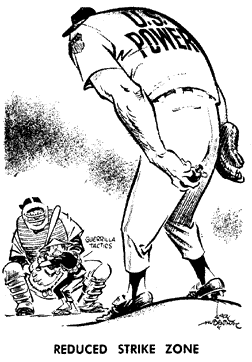
Few cartoonists
had better command of their medium than did Hubenthal. His original
art is simply breathtaking, the brushwork and pen strokes always
exuding uncommon confidence. In this 1966 editorial cartoon (above)
, Hubenthal invokes a sporting theme to editorialize (and not
too politically-correct by today's standards) on the subject
of North Vietnamese "guerrilla tactics"
|
|
He worked large --
typically 12" x 16" for an editorial cartoon -- and
owing to his meticulous nature, the tips of his brushes were
always sharp with rarely a wisp of sable out of place. After
lightly penciling in his drawing, he would begin inking in brush
strokes that appeared at the same time both spontaneously slashed
and purposefully placed, a "zone" of sorts that he
surely felt himself slip into when the ink spread just right,
the brush danced ever-so-lightly, and his creative spirit urged
him to simply enjoy himself at the drawing table.
Yet his ability and
confidence engenders artwork that will technically reproduce
well, Hubenthal's use of coquille board certainly complemented
the bravado of his india-inked lines. He used the pebble-embossed
|
board because
it was created for the distinct purpose of ensuring that drawn
gray areas would indeed print as gray -- and not mud. After inking
his artwork, Hubenthal would rub a grease pencil, or chunk of
conte crayon, against the paper, the black picking up the raised
surface, while allowing portions of the white paper beneath to
show through -- thus, the "illusion" of gray when the
artwork was photographically reduced, and ultimately reproduced.
However, Hubenthal's
acceptance that his art would be primarily printed, rather than
hung on a gallery wall, did not prompt him to simply "draw
for reproduction", a time-saving tactic used by many deadline-pressured
commercial artists. Rarely does one find cut out elements on
a Hubenthal original, or new faces glued over old (inferior)
ones. Liquid paper or opaque white masked out real estate on
Hubenthal's coquille board? I've never seen it. In Hubenthal's
mind, problem solving at the drawing table was done during the
penciling out stage -- and when he inked, he committed himself.
Clearly, he approached his editorial and sports cartoons as fine
art -- not as simple, fleeting, reflective matter for a dark
room negative camera.
Another testament to
his generosity, when asked to talk at civic groups, Hubenthal
would often bring along an armful of original drawings. "After
the talk", recalled his wife, Elsie, "he'd spread them
out on a table and tell everyone to feel free to take a couple."
|
-
- While a student at Hollywood High School in 1934, Hubenthal first met
Willard Mullin, the long reputed "Dean
of Sports Cartooning". Mullin's work, particularly the joyous
spontaneity of his linework and his understanding of the human
form, remains awe-inspiring to this day. So it's no surprise
that when Mullin took the talented youngster under his wing,
more than a little Mullin rubbed off on Hubenthal. Throughout
his life, Hubenthal affectionately referred to Mullin as "Uncle
Will", and Mullin respected the younger cartoonist's work
so much that he once said "your stuff looks like mine on
a good day!". Hubenthal was always tickled by Mullin's quotable
endorsement, but looking at the body of their work, the argument
can be made that Hubenthal was technically a far more talented
sports cartoonist than Mullin.
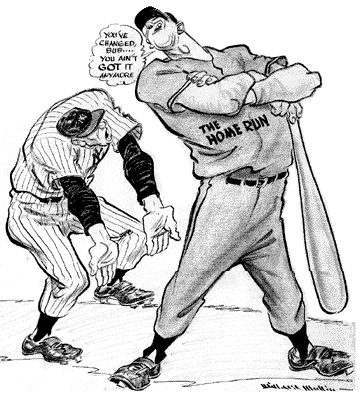 |
|
Classic Willard
Mullin (left) -- Hubenthal always referred to his mentor as "Uncle
Will"
(Collection
of Bob Staake)
|
-
| It's a controversial assertion,
one not made often, yet as an avid student of their work, it
is clear that Hubenthal may have built on a graphic foundation
of Mullin aesthetics, a comparitive study of their original artwork
graphically demonstrates this. It was Mullin who first adapted
a most unusual way of inking with a brush, dripping it into the
ink, then probably making a couple test slashes to remove most
of the ink from the brush, causing the bristles to "split",
the result being two, three even or four side-by-side, parallel
brush lines. |
 |
|
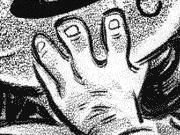 |
| Willard
Mullin's (circa 1945) "split brush" effect... |
|
...evident
as well in this 1957 Hubenthal sports cartoon |
-
| The Mullin effect was subtle,
often diminished (or altogther negated) in the reproduction process,
but Hubenthal was apparently intrigued enough to experiment with
the same technique -- if only for a while. However, once he firmly
understood his mentor's work and moved beyond the youthful, graphic
emulation stage, Hubenthal developed wings and soared entirely
on his own -- in all likelihood intentionally dropping his graphic
idolatry of Mullin, as continuing it would have been professionally
unwise. Ultimately, Hubenthal's work became far more graphic,
animated, intentional and aesthetically inspired than Mullin's
ever was. |
-
|
Nonetheless, it must be pointed
out that Mullin's output of sports cartoons and sport-related
illustration was far more than Hubenthal's, and for his prolific
body of work alone, Mullin will always have his more than rightful
place in cartooning history. Hubenthal's sports art developed
a more regionalized following and acceptance (primarily in Southern
California), while Mullin's reach was more national in scope.
Classic Karl
Hubenthal (Right) -- Detail from an April 21, 1972 sports cartoon
|
|
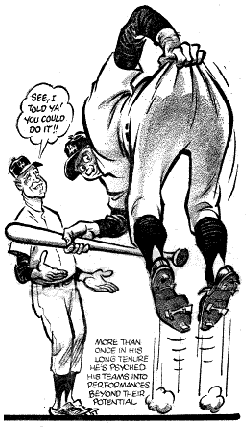 |
-
- Strip Mullin of the
unofficial (yet broadly accepted) moniker of "Dean of Sports
Cartooning"? Certainly that's ridiculous, and the suggestion
alone would have made Hubie uncomfortable. Yet when the subject
of sports cartoons is approached and names like Mullin, Ray
Gotto and Bill Gallo are tossed about, no authoritative discussion
of the topic can be complete without invoking the name of Karl
Hubenthal.
|
|
He never won the Pulitzer Prize, though it has been reported
that he was nominated five times.
Hubenthal was literally
hand-picked by William
Randolph Hearst
to become a political cartoonist -- it wasn't something
he necessarily desired to be, and he certainly never trained
for such a vocation. It's unclear what Hearst saw in Hubenthal's
sports cartoons and humorous illustrations (other than his obvious
artistic talent) to convince him that he could become a political
cartoonist.
| Historically,
Hubenthal's political cartoons were always anchored in an illustrative,
rather than a commentative, mind set. Often his cartoons are
clever visual twists on a news headline of the day, and just
as often Hubenthal failed to "go out on a limb" by
presenting a strong self-editorialized point of view, except
for his omnipresent, if sometimes only hinted at, conservative
leanings. He took strong, conservative stands on push-button,
emotional issues such as draft "dodgers", anti- Americanism,
military spending,and even Richard
Nixon. |
|

October 29,
1962 editorial cartoon (above) on the Cuban Missile Crisis. Here
an always pro-American Hubenthal practically gloats over the
Kruschev "retreat" in the face of American force. As
good as any editorial cartoon of the day, and exactly the kind
of work that was begetting Pulitzers Prizes for American cartoonists.
(Collection of Elsie Hubenthal)
|
Indeed, Hubenthal remained
a Nixon supporter -- even embarrassingly so -- almost to the
end. It wasn't until the 1974 release of the secret tapes that
Hubenthal (and other, hard-line Republicans) began to question
Nixon the Man. Even when Nixon was forced from office, Hubenthal
focused on the "tragedy" of his departure, an emotional
reaction if there ever was one, rather than boldly commenting
on the bigger issues surrounding Nixon's fall from grace.
Strictly on an aesthetic
level, Hubenthal is best remembered -- and was certainly viewed
in the contemporary context of 1960s and 1970s journalism --
as an "old Guard" editorial cartoonist, comfortable
with old-fashioned coquille board and grease pencil, labeling
his characters and props with verbs, nouns and adjectives such
as "executive privilege", "reform attempts",
and "Red China".
More than ever with
the emergence in the 1970s of a more British approach to visual
satire in the American political cartoon (ushered in by Pat Oliphant, and supported by Jeff MacNelly,
Mike Peters, Don Wright,
et al), Hubenthal's work had that "look" of being less
than modern. Other old guarders -- including Tom Englehardt, Don
Hesse, and to some
degree Bill Mauldin -- were surely looked at in
the same light. Ironically, both Herblock
and Paul Conrad continued to work on coquille
board as well, though the two have always used their cartoons
as vehicles for projecting their liberal commentary, Conrad even
asserting that a good political cartoon is "95% idea",
only five percent drawing.
|
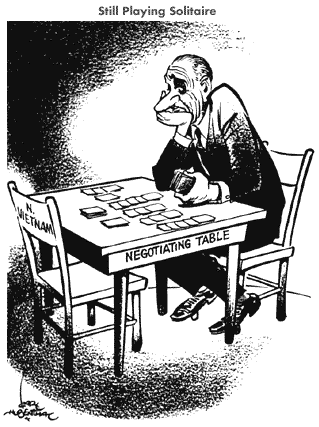
As deserving
as any editorial cartoonist to bring home a Pulitzer, Hubenthal
ultimately received five nominations throughout his career --
but never the award itself. In this circa 1966 cartoon, Hubenthal
remains as pro-American as ever by supporting President Johnson's efforts to end the Vietnam War.
Indeed, Hubenthal, a lifelong Republican, would always align
himself on the pro-American side, even when it meant supporting
a Democrat like LBJ.
|
|
In Los Angeles, Hubenthal
was also the victim of Conrad's notoreity. Conrad, after all,
won Pulitzers (three in all) with oftentimes vicious, scathingly
strong political commentary. In fact, so liberally-minded was
Conrad that he even made Richard Nixon's infamous "Enemies
List". Juxtaposed next to one another, Conrad's cartoons
in the respected Los
Angeles Times may
have had the effect of almost dismissing Hubenthal's Herald-Examiner cartoons as nothing more than
"illustrations" (to use Conrad's own word) of
|
headlines. Even
while they worked at the competing newspapers, the two rarely
communicated -- partly, itcan be assumed, because each cartoonist
was on opposite ends of their political philosophies. Between
Conrad and Hubenthal, one gets the sense that there was no love
necessarily lost.
Regardless, it remains
a mystery why Hubenthal never did bring home a Pulitzer in his
career-- especially given that, up until the 1970s, it could
be argued that the award was bestowed on cartoons that projected
a decidedly jingoistic, pro-American point of view -- an ideology
from which Hubenthal was never far removed. Pat Oliphant
first saw this pattern in the mid 1960s with the Pulitzer award
process and calculatedly submitted cartoons with clear, blatantly
patriotic themes. The result? Oliphant won his first Pulitzer
in 1967.
Was Karl Hubenthal
overlooked by the Pulitzer Board? If you understand what the
award was in the 1960s and 1970s, and if you remain a student
of the historical recipients -- most worthy, some not -- the
answer is an undeniable "yes".
|
-
- In July of 1975, Hubenthal
effectively quit creating his editorial and sports cartoons with
pen, brush, ink and grease pencil on coquille paper and began
using "Grafix" board -- the specially-manufactured
paper used by practically all editorial cartoonists since 1972
or so, but he gave the paper, at least initially, a less than
ringing endorsement. In a July 15, 1975 letter to me, Hubenthal
wrote:
-
- "...about the
chemical benday (Grafix) paper I have been
- experimenting with
for the last two weeks, I'm not sure I will
- continue to use it
or not. It tends to become a little too
- mechanical for my
tastes."
-
- Mechanical indeed.
Grafix is a board (or paper) in which mechanical gray tones are
invisibly printed, and to reveal them a cartoonist must brush
a chemical developer to make halftones appear, and though Hubenthal
may have questioned the paper initially, he did in fact use it
exclusively until his retirement from the Herald-Examiner in 1981.
-
|

As this original
Hubenthal "Grafix" board editorial cartoon of 1980
attests, the chemical compounds in the paper do not age gracefully,
causing the gray areas to become splotchy (or even disappear)
over time.
|
-
- While Hubenthal's
1975-1981 work reflected noticeable aesthetic experimentation
(and not always for the better), his Grafix board work appeared
flat, even less meticulous than his work of decades past --attributable
in part to his working smaller (approximately 10" vertical
by 12" horizontal). Coquille board, however "old-fashioned"
a drawing surface, had always been Hubenthal's home turf -- the
place where he always performed best -- and so it remains a mystery
why he continued working on Grafix board, particularly given
his stated concerns over the medium's "mechanical"
nature.
-
- I can only speculate
that his continued use of Grafix came from circulation-wary Herald-Examiner (or Hearst) executives who
may have "suggested" Hubenthal use the same paper that
editorial cartooning's (younger, broadly syndicated) practitioners
-- from Peters to MacNelly,
Oliphant to Auth
-- were utilizing. This argument can be further supported in
light of Hubenthal making a complete editorial cartoon format
change around the same time -- from vertical to horizontal. In
1975, vertical format editorial cartoons were becoming uncommon,
even viewed as passe, and when Hubie adopted the horizontal
format, editorial cartooning's remaining "vertical formatters"
could be counted on a single hand. Hubenthal's cartoon changes
also roughly coincided with the Herald's
newly-introduced tabloid format -- clearly the paper's effort
to boost lagging circulation figures and make a last-ditch effort
to take on (with any measure of success) the powerhouse Los Angeles Times.
|
|

